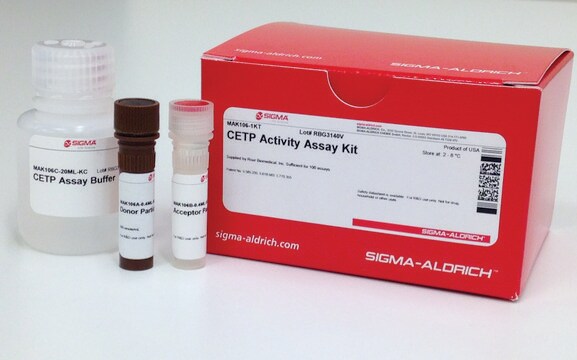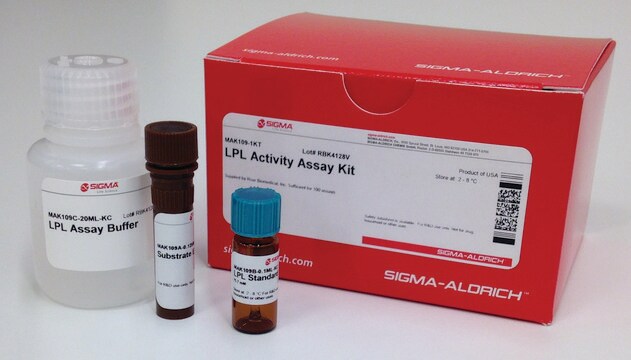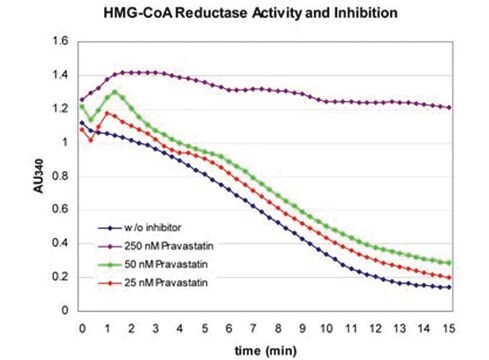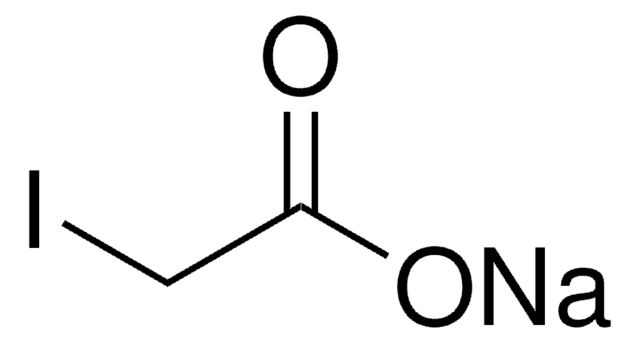MAK107
LCAT Activity Assay Kit
Supplied by Roar Biomedical, Inc.
Synonyme(s) :
Lecithin:cholesterol acyltransferase activity assay kit
Se connecterpour consulter vos tarifs contractuels et ceux de votre entreprise/organisme
About This Item
Produits recommandés
Utilisation
sufficient for 100 fluorometric tests
Application(s)
pharmaceutical
Méthode de détection
fluorometric
Maladie(s) pertinente(s)
cardiovascular diseases
Température de stockage
−20°C
Informations sur le gène
human ... LCAT(3931)
Description générale
The plasma protein lecithin:cholesterol acyltransferase (LCAT) catalyzes the transfer of an acyl group from the sn2 position of phosphatidylcholine to the 3-hydroxyl group of cholesterol resulting in the formation cholesteryl ester. This enzymatic activity occurs on the surface of high density lipoprotein (HDL). The cholesteryl esters formed by LCAT may be packed into the core of HDL.
Application
Applications for this method include high-throughput screening, mechanism of action studies and structure-activity relationship (SAR) work.
LCAT Activity Assay Kit has been used for measuring lecithin-cholesterol acyl transferase activity in plasma samples.
Caractéristiques et avantages
Compatible with high-throughput handling systems.
Adéquation
Suitable for measuring phospholipase activity of LCAT in plasma or serum.
Principe
The LCAT Activity Assay Kit is a fluorometric assay useful for measuring phospholipase activity of (λEx=390 nm/λEm=470 nm) LCAT. The assay may be validated by inhibition of LCAT with iodoacetate or another spectrally benign (not Ellman′s reagent) LCAT inhibitor.
Remarque sur l'analyse
Composants de kit seuls
Réf. du produit
Description
- Substrate Reagent .1 mL
- READ Reagent 30 mL
- LCAT Assay Buffer 20 mL
Produit(s) apparenté(s)
Mention d'avertissement
Danger
Mentions de danger
Conseils de prudence
Classification des risques
Acute Tox. 3 Dermal - Acute Tox. 3 Inhalation - Acute Tox. 3 Oral - Flam. Liq. 2 - STOT SE 1
Code de la classe de stockage
3 - Flammable liquids
Point d'éclair (°F)
49.5 °F
Point d'éclair (°C)
9.7 °C
Faites votre choix parmi les versions les plus récentes :
Déjà en possession de ce produit ?
Retrouvez la documentation relative aux produits que vous avez récemment achetés dans la Bibliothèque de documents.
Les clients ont également consulté
Reversal of high fat diet-induced obesity through modulating lipid metabolic enzymes and inflammatory markers expressions in rats.
Uddandrao V V S, et al.
Archives of Physiology and Biochemistry, 1-7 (2018)
Anatol Kontush et al.
Arteriosclerosis, thrombosis, and vascular biology, 27(8), 1843-1849 (2007-06-16)
The purpose of this study was to define heterogeneity in the molecular profile of lipids, including sphingomyelin and sphingosine-1-phosphate, among physicochemically-defined HDL subpopulations and potential relevance to antiatherogenic biological activities of dense HDL3. The molecular profile of lipids (cholesteryl esters
Yan Ru Su et al.
Molecular therapy : the journal of the American Society of Gene Therapy, 8(4), 576-583 (2003-10-08)
The antiatherogenic effect of high-density lipoprotein (HDL) and its major protein component apolipoprotein A-I (apoA-I) has been largely attributed to their key roles in reverse cholesterol transport (RCT) and cellular cholesterol efflux. Substantial evidence shows that overexpression of human apoA-I
E Nobécourt et al.
Diabetologia, 48(3), 529-538 (2005-02-25)
Elevated oxidative stress, hyperglycaemia, and dyslipidaemia involving low levels of HDL particles are key proatherogenic factors in type 2 diabetes mellitus. We examined the relationship of oxidative stress, and the degree of glycaemia and triglyceridaemia, to antioxidative function of HDL
Ameliorative potential of gingerol: Promising modulation of inflammatory factors and lipid marker enzymes expressions in HFD induced obesity in rats.
Naidu P B, et al.
Molecular and Cellular Endocrinology, 419, 139-147 (2016)
Notre équipe de scientifiques dispose d'une expérience dans tous les secteurs de la recherche, notamment en sciences de la vie, science des matériaux, synthèse chimique, chromatographie, analyse et dans de nombreux autres domaines..
Contacter notre Service technique








